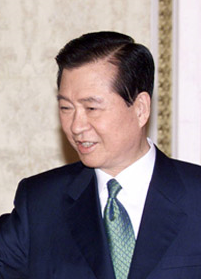Kidnapping of Kim Dae-jung
This article needs additional citations for verification. (August 2013) |

The South Korean dissident leader Kim Dae-jung, later president of South Korea, was kidnapped on August 8, 1973, in Tokyo, Japan.
Background
In the South Korean presidential election, 1971, Kim represented the Democratic Party, challenging incumbent President Park Chung-hee of the Democratic Republican Party (South Korea). Kim won 45.3% of the popular vote but narrowly lost to Park's 53.2%, by about 900,000 votes. Following the election, Kim was involved in a car accident which left him with a permanent injury on his hip joint. Believing the accident to be an attempt on his life, Kim fled to Japan where he eventually began an exile movement for democracy in South Korea, following Seoul's declaration of the Yushin Constitution in October 1972. With widespread allegations of corruption and manipulation of the results, Park turned his regime into a military dictatorship.
Kidnapping
Around noon of August 8, 1973, Kim was attending a meeting with the leader of the Democratic Unification Party held in the Room 2212 of the Hotel Grand Palace in Tokyo. At around 13:19, Kim was abducted by a group of unidentified agents as he walked out of the room after the meeting. The entire rest of the floor of that hotel was rumored to have been rented out by a notorious yakuza syndicate run by the South Korean national Machii Hisayuki, a man long known to have extensive ties to the KCIA. He was then taken into the empty Room 2210 where he was drugged and fell unconscious. Later Kim was moved to Osaka and later to Seoul, South Korea.
Kim was later quoted as saying that a weight had been attached to his feet aboard the boat heading toward Korea, indicating that the kidnappers had intended to drown him by throwing him into the sea. They were, however, forced to abandon this plan as the Japan Maritime Self-Defense Force began a pursuit of the kidnappers' boat, and they fired an illuminating shell just when the kidnappers brought Kim on the deck. Subsequently Kim was released in Busan. He was found alive at his house in Seoul five days after the kidnapping.
According to some reports, Kim was only saved when U.S. Ambassador Philip Habib found out the KCIA was involved and intervened with the South Korean government.[1]
NIS inquiry
On October 24, 2007, following an internal inquiry, South Korea's National Intelligence Service (NIS) has admitted that its precursor, the Korean Central Intelligence Agency (KCIA), undertook the kidnapping, saying it had at least tacit backing from then-leader Park Chung-hee.[2][3]
Fiction
The film KT (2002) depicts the kidnapping of Kim Dae-jung.
References
External links
- Kim Dae-jung
- Crime in Japan
- Espionage scandals and incidents
- History of South Korea
- Kidnapped politicians
- Kidnapped South Korean people
- Political repression in South Korea
- Terrorism in Japan
- 1973 crimes in Japan
- 1973 in international relations
- Fourth Republic of South Korea
- Yakuza
- Kidnappings in Japan
- Crime in Tokyo
- 20th century in Tokyo
